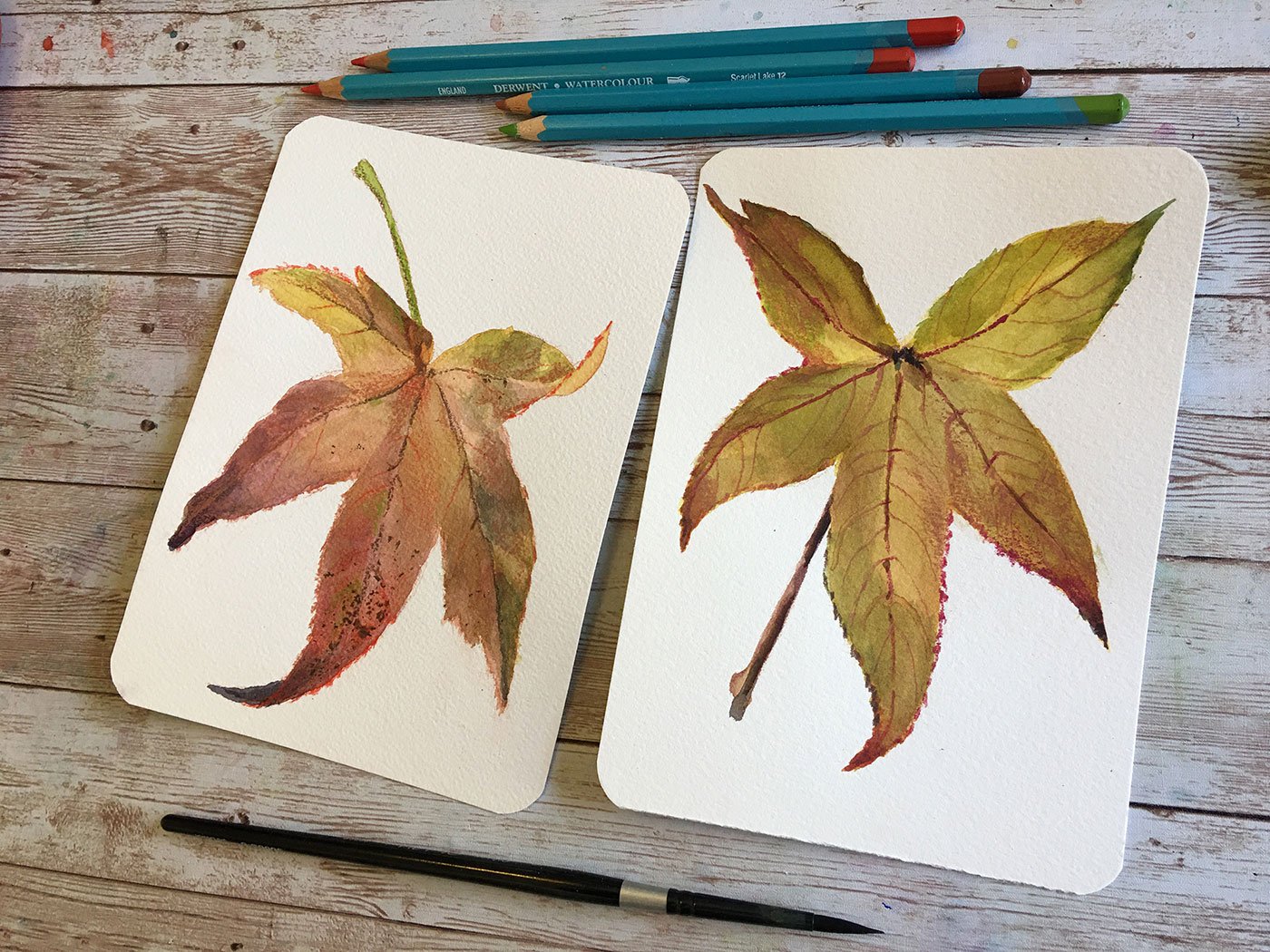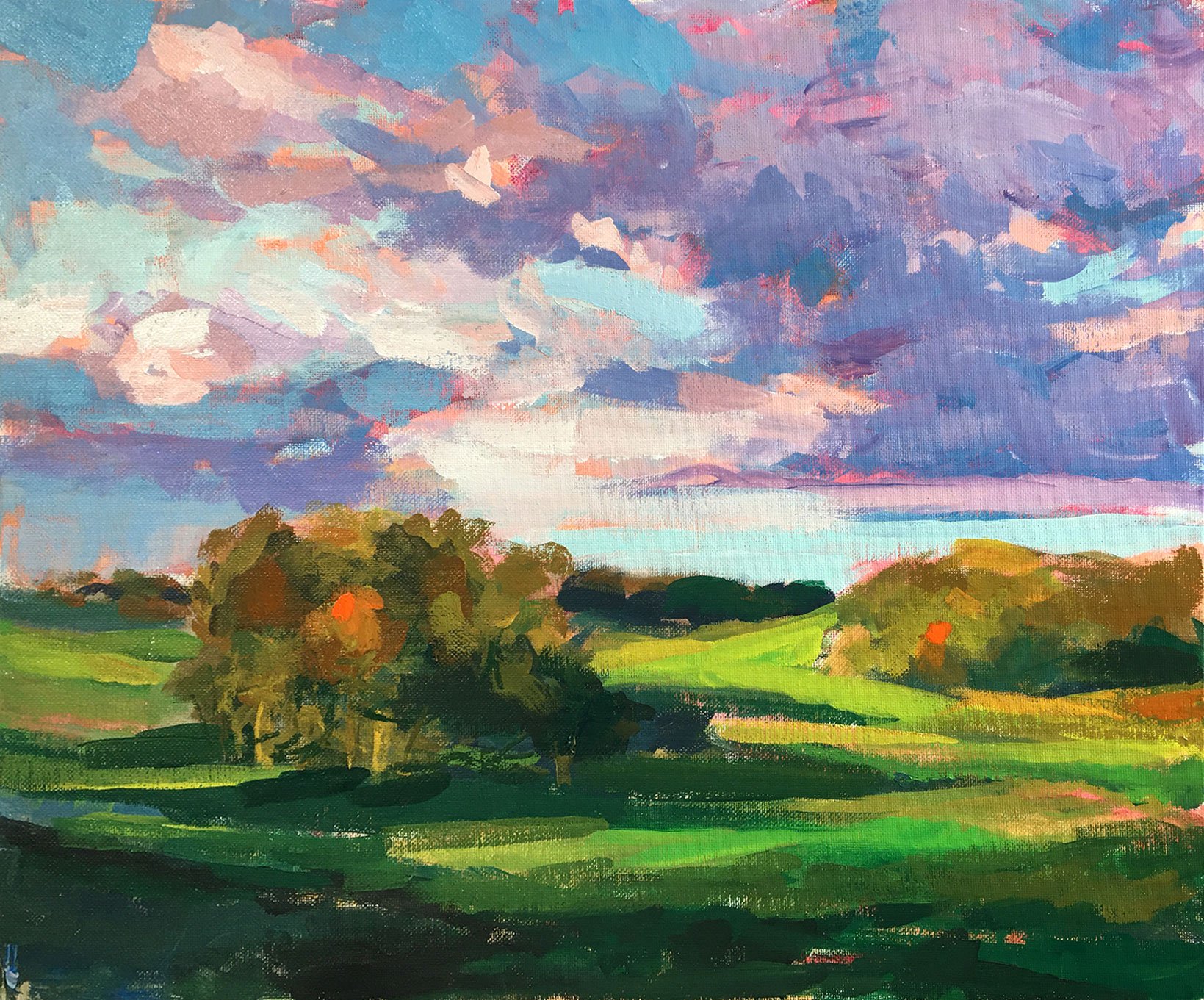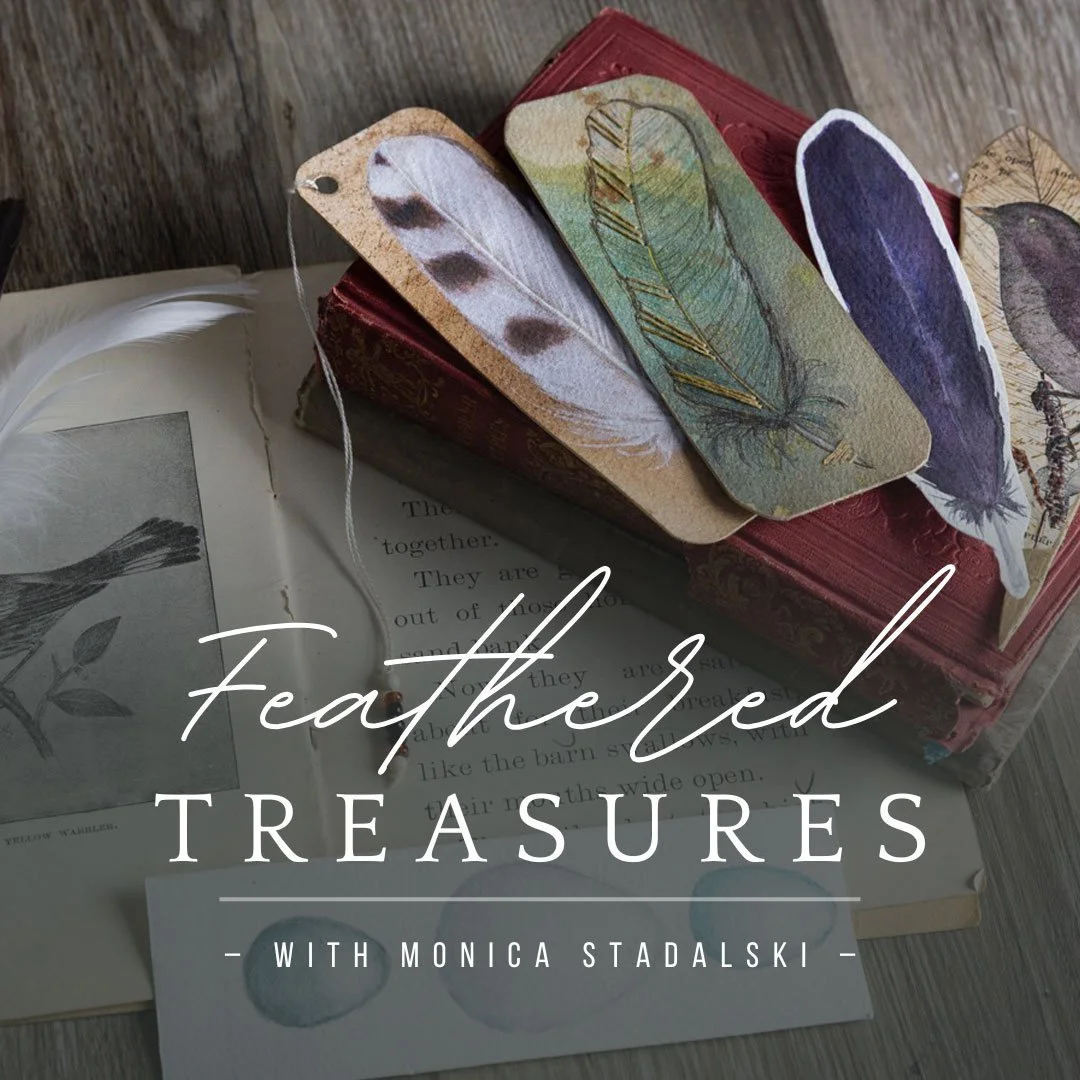Welcome painters, artists and nature lovers!
What gets our painting to be as powerful as the nature we paint? I believe that great painting is an alchemy of accident and intent. It's both unconscious and highly aware, both controlled and uncontrolled - and with a little insight, your road to great painting is open to you.
When we paint nature and landscape - how do we know what to do? How can we approach the blank page, decide what's next, and hone our skills in our observational sketches?
This class is a synthesis of ways of knowing our world. I've set out to introduce prized aspects of the landscape painter's toolkit in a way that is fun, curiosity-provoking, and deeply rewarding.
We'll be learning about Master Artist Alexander Cozens and his surviving work, especially his work as a teacher. We'll even revive his "blotting technique" to create a fanciful warm-up watercolor landscape.
We'll go deeply and mindfully to create a watercolor and mixed media botanical leaf painting from photographic resources. The tightly controlled watercolor layering looks back as far as the 18th century, but we get to use photos for our out-of-season botanicals, and a world of color the early landscape artists could only dream of!
We'll learn brush and water control methods to make friends with the lesser-known personality of watercolor - as a tight, controllable, precise medium that lends itself to rich realistic textures.
We'll get into our sketchbooks/journals and we'll have the option to switch to opaque paints, as we create landscape studies based around gesture and unconscious high-speed marks. As we study, we'll learn what makes a few marks and colors successfully arrange themselves into a space. There are no rules in art - but if you choose to follow the rules in this lesson, you'll be able to world build landscapes from imagination!
We'll even cover two point perspective and its untrue myths - that it's boring (it's fun) and that it's hard (it isn't!)
We'll pull together all the information we've learned. Observation from photos. Blots and accidents, The "rules" of landscape. The underlying perspective. A gorgeous inspiration photo. At last, we'll create a bold, colorful, modern, and exciting landscape with roots in the tradition of watercolor, observation, and forgotten fantasy.
I can't wait to see you in class, and I can't wait to share this nourishing and refreshing deep-dive into nature and landscape with you.
Class Is Open!
Only $67.00
{ LIFETIME ACCESS • DOWNLOADABLE VIDEOS }
What we will learn together…
Warmup lesson : A NEW METHOD
For me, valuable insight into my ever-present painting questions arrived from the unlikeliest of Master Artist sources. Watercolorist Alexander Cozens was a lesser known trailblazer who was teaching his students with surprisingly modern methods in 18th century England.
We'll learn about Cozens and his limited surviving art, as well as his unorthodox process. We'll try out a modern and updated version of his "new method" to get used to using our imagination and get introduced to our extremely vintage (18th and 19th century) approach to water control in the watercolor part of this class.
ALEXANDER COZEN
ALEXANDER COZEN
lesson 1 : LOOKING DEEPLY
It's no secret that I love to paint loose watercolor - but watercolor also has a long and storied history as the medium of scientific illustration and careful, controlled, observational painting.
In this lesson, we'll create postcard-sized botanical paintings from photo references of sweetgum leaves and we'll examine issues of observation, paint control, and water control that point back to methods that Cozens and his contemporaries would recognize.
This is a deep dive into technique, material, and method. If you've ever wondered "how should I load my brush" or "how do I get a smooth wash" this class will answer these questions. If you are uncomfortable drawing, a traceable template will be available, but I encourage you to try the process start to finish, spending time learning a gentle lifelong practice of growing accuracy.
The purpose of this lesson is to tune our senses to see - see more, look slower, notice our own effects on our materials.
Lesson 2 : STUDY AND SPACE
Art has no rules at all. Art has immutable laws that you must sometimes keep. How can both of these ideas be true at once? And how can we tap into the power of each viewpoint to make our best and most effective paintings yet?
We'll get out some pencils, cheap sketch paper, our sketchbooks and journals, a ruler, and some opaque paint we're not too precious about using. It's study time, and it's the MOST fun. We'll learn how to create landscapes from imagination and intuition using value, color intensity, color temperature, and finally how to use two point perspective to build theoretical three dimensional worlds that work - all while having non-rigid and exploratory good times with your ruler. Really!
Lesson 3 : ORCHESTRATING BEAUTY
It's time to put together all the things we've explored and learned in a beautiful and radiant final painting.
Using your choice of water-based paints, we'll create a color-drenched landscape using observation from a photo reference, what we've learned about color and value, what we've learned about two point perspective, and what we've come to trust in our fastest and most intuitive painterly ways.
We'll also explore "broken color" as a way to paint fresh, bold, contemporary landscape that still leaves us places for contemplation and careful design.
Bonus resources
As a bonus you'll get some of my original traceable botanical drawing templates so you can add more botanical postcard paintings to your collection with ease.
We'll also take a virtual "photo walk" looking for opportunities to use our two point perspective - when is this the right number of vanishing points for a scene we want to paint and when is it not the right fit?
Class Is Open!
Only $67.00
{ LIFETIME ACCESS • DOWNLOADABLE VIDEOS }
Who’s This Class For?
This class is for paint-loving creatives who love to go both bold and big and intimate and studious.
Nature is an endless source of inspiration for art - and the ways that we process and use that inspiration can be limitless and freeing. This class will build your artist's toolkit with exciting new strategies and ways to play - so that you can concept and paint worlds as beautiful as your dreams!
You will learn…
More about watercolor master Alexander Cozens and his techniques.
Brush and paint application techniques (both watercolor and acrylic).
Two point perspective.
Value and composition.
Color techniques and application tips.
Heighten your observation and drawing skills.
AND much MORE!
Class Is Open!
Only $67.00
{ LIFETIME ACCESS • DOWNLOADABLE VIDEOS }
HERE ARE JUST A FEW EXAMPLES OF Dena’s WORK
SUPPLIES LIST
This class consists of a watercolor component (the first lesson and warmup) and a mixed media/ acrylic/gouache option. I'll be moving from transparent watercolor to opaque acrylic. You can do the same, but you don't have to, it's up to you. For the sketchbook portion of the class, "use what you have" is especially relevant.
WATERCOLOR
I like M Graham for in-studio use and Rembrandt for squeezing into pans. Colors Used:
Dioxazine Violet
Benzimidazolone Yellow OR New Gamboge, OR Nickel Azo Yellow
Pthalo Green Blue Shade
Pyrrol Scarlet OR Pyrrol Orange OR Benzimidazolone Orange
Quinacridone Magenta
PAPER AND SUPPORTS
For warmup and lesson one I will be working on Arches 140 cotton cold press, cut to 5x7 inches. Fabriano, Saunders, Blick, Kilimanjaro, Baohong, Fluid 100 - any cotton 140 pound cold pressed paper will work for the watercolor portion of this class. Feel free to continue on a larger cotton paper if you want to use watercolor and then gouache or acrylic on top for your final.
For the second lesson, work in your sketchbook/journal, provided the paper can handle a little wet paint, or use dry media if you prefer. Also have some cheap and large sheets of scratch paper to practice 2 point perspective on.
For the final project, you can use your cotton paper, or a canvas, or canvas panel (I use canvas panel) or you can use a painting pad - Canson XL and Strathmore make painting papers which are great for practice. I use a 16x20 inch canvas panel for the demo. 16x20 is a great size.
OPAQUE STUDY PAINT
For study, you can use gouache or craft/student acrylic in black, white, and a warm and cool color. Gray is optional but nice. I used Black, Gray, White, Lemon yellow, Ultramarine Blue, and Napthol Red from Liquitex Basics. This is an excellent study palette for learning mixing and adjusting, and almost all manufacturers will provide these colors in their student and artist paints, whether your set is large like my set of 48 or you get the colors individually.
SKETCHING MATERIAL
Pencil
An alternative color or two of pencil for clarity Straightedge / Ruler/ Yardstick
Light Hold Masking Tape
PAINTS FOR FINAL (OPTIONAL)
Use your study paints if you want, but if you would like to use the same paint colors I did, any artist grade acrylics will have these colors available:
Lemon Yellow OR Cadmium light hue OR Cadmium free Yellow light OR Cadmium yellow light
Pyrrol Orange OR Vat orange OR Cadmium Orange OR Perinone Orange OR Vermillion Hue
Pthalo Blue (Green or red shade are both fine)
Pthalo Green Blue Shade
Quinacridone Magenta
Titanium White
This group is an amazingly vibrant and flexible mixing palette, you won't regret any color on it and you will be able to mix almost anything. I like Liquitex, Golden, and Amsterdam Expert equally.
You can also use gouache on paper instead of acrylic, the same colors will be available.
BRUSHES
WATERCOLOR BRUSHES:
size 6 or 8 faux squirrel like Trekell Onyx or Princeton Neptune
Size 4 or 6 faux sable like Trekell Protege or Princeton Aqua Elite or 4050
Size 2 inexpensive synthetic round detail brush, short bristles ideal I used
Creative Mark Mimik faux squirrel
Don't use these with your acrylic paints and they will last.
ACRYLIC BRUSHES:
Use what you have/like - a good setup is:
1/2 inch flat
6 Flat
4 round Rigger/liner/detail
Royal Langnickel brushes are great for acrylic - available, cheaper, nice enough, and reliable.
EXTRAS
Paper Towels (so important)
Nitrile/rubber gloves if you like to paint dirty Water/Water containers
Craft Knife/Utility Knife Light Masking Tape
Photo Reference Printouts Easel/table easel/ board (optional)
220 grit sandpaper (if you have stray pencil marks on your paper you want to get rid of)
MIXED MEDIA
Watercolor pencils to coordinate with your art. Greens Browns Reds if you are doing the leaf image as I am.
I pulled from my set of Water Soluble colored pencils by Lyra (Rembrandt) and an old set of Derwent Watercolor Pencils.
I like the Derwent, though many folks find them too chalky.
Colored pencil, pen, ink, or pastel pencil can also work - use what you like best.
Latest Classes
TAKE A LOOK AT OUR LATEST CREATIVE CLASSES AVAILABLE. REGISTER NOW!























When you join Studioworks, you'll enjoy FULL ACCESS to over 200+ Creative Classes, Studioworks Creative Journals, Live Events, Private Creative Group and so much more!
Each and every month you will be supported in your creative journey through teachings I will be sharing with you in the Studioworks Journal. This specially crafted online magazine is packed with inspiration, guidance, sketchbook explorations, creative prompts and MORE!